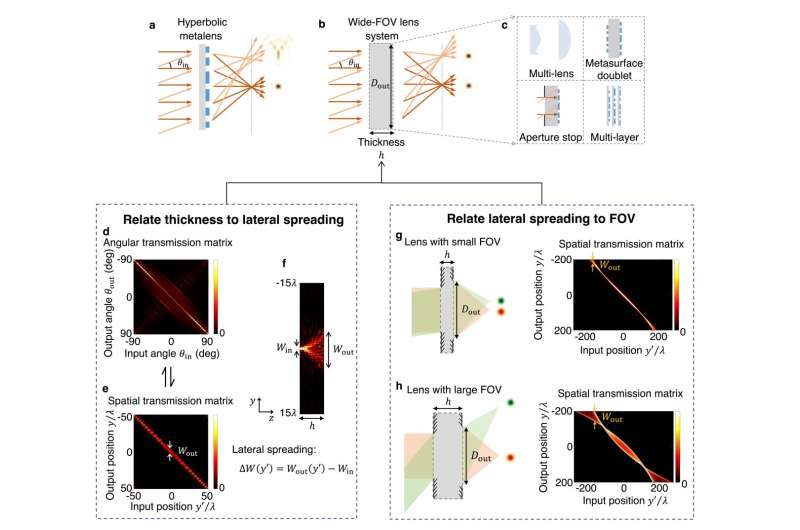Examining the limits of nonlocal wide-field-of-view metalenses

Metalenses, compact lenses made with metasurfaces, have the potential to enable thinner, lighter, cheaper, and better imaging systems for a wide range of applications where miniaturization is critical (e.g., for mobile devices, medical imaging, and augmented reality).
Achieving a sufficient angular field of view (FOV) within a compact size is crucial for these applications. A single-layer of subwavelength-thick metasurface with a hyperbolic phase profile can focus normal-incident light to a diffraction-limited spot, but suffers from strong aberrations under oblique illumination, which severely limit the angular FOV.
To achieve wide FOV while maintaining diffraction-limited focusing quality, one can use metasurface doublets or triplets, add an aperture stop, or resort to inverse-designed multi-layer structures. All of these approaches involve a thicker system where the thickness plays a critical role.
These point to the scientifically and technologically important questions: is there a fundamental trade-off between the FOV and the thickness of a metalens system (or lenses in general)? If so, what is the minimal thickness allowed by physical laws?
In a new paper published in Light: Science & Applications, researchers from the Ming Hsieh Department of Electrical and Computer Engineering, University of Southern California, established the relation between angular diversity and spatial footprint using a transmission matrix framework and applied it to wide-FOV metalenses.
These scientists introduce the procedure to establish the thickness bound:
"Intuitively speaking, given a thicker device, incident light can spread more when it reaches the other side due to diffraction. So, we can relate the device thickness to this lateral spreading encoded in the transmission matrix. This lateral spreading is also closely related to the angular FOV because angle and space are related through Fourier transforms."
"A time-frequency analogy is that when a pulse propagates through a dispersive medium, increasing the spectral bandwidth makes the input pulse shorter but with more pulse stretching during propagation because the output spectral phase is misaligned over a larger bandwidth. Here, a metasurface with large angular field of view has a broad angular bandwidth, so a localized wave propagating through it must spread and become less localized."
"We can quantify this lateral spreading using the transmission matrix, and then establish the relation between the FOV and device thickness."
"The recipe is general. Given any desired angle-dependent response, we can write down its transmission matrix, determine the lateral spreading of localized incident waves, from which we determine the minimal device thickness. This approach works across different designs, such as single-layer metasurfaces, cascaded metasurfaces, diffractive lenses, bulk metamaterials, and thick volumetric structures," they commented.
More information: Shiyu Li et al, Thickness bound for nonlocal wide-field-of-view metalenses, Light: Science & Applications (2022). DOI: 10.1038/s41377-022-01038-6
Journal information: Light: Science & Applications
Provided by Light Publishing Center, Changchun Institute of Optics, Fine Mechanics And Physics, CAS





















